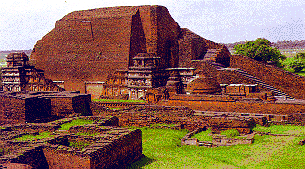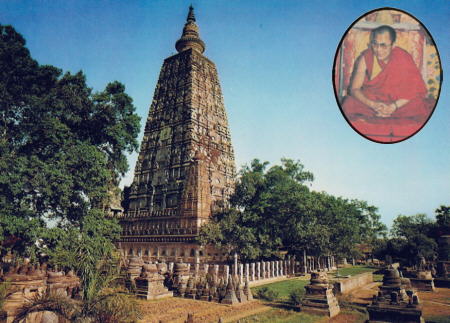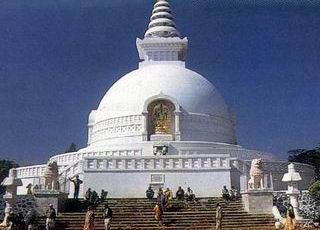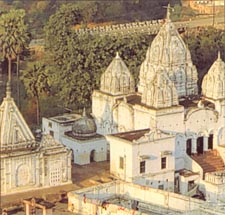Beneath the din
and bustle of Patna, the capital of Bihar state, has a
fascinating past. And in each chapter of its history, it has
been crowned by a new name – Kusumpur, Pushpapur, Patliputra
and Azeemabad.
Turning over the pages of early Indian history one comes
across the name of the pre-eminent city of Patliputra.
Located at the site where Patna is today, this city saw the
rise and fall of India's first major kingdoms. Its period of
glory spanned a thousand years, from 6th century BC to 6th
century AD. After the decline of the Mughals, the British
too found Patna a convenient regional capital and built a
modern extension to this ancient city and called it
Bankipore. It was in Gandhi Maidan in this area that Mahatma
Gandhi held his prayer meetings.
General
Information
|
Altitude
|
55 meters
|
|
Best Season
|
October to March
|
|
Temperature
|
Summer - Max. 43, Min. 21; Winter - Max. 20, Min. 6
|
|
STD Code
|
0612
|
How to get
there
Air
Patna is connected with Bombay, Calcutta, Delhi, Lucknow,
Ranchi.
Road
Patna
is connected to Nalanda-90 km, Rajgir-102 km, Pawapuri-90
km, Gaya- 172 km Bodhgaya-179 km, Raxaul-210 km, Ranchi-335
km, Muzaffarpur-72 km, Sasaram- 152 km, Vaishali-56 km,
Calcutta-653 km, Delhi-997 km.
In and around
Kumrahar
Site of the ancient city of Patliputra. Excavation here have
revealed relics of four continous period from 600 BC to 600
AD. The fifth period begins from 1600 AD. An important kind
is the 80 pillared huge hall of the Mauryan dynasty.
Golghar
This huge and impressive beehive-shaped structure was
constructed in July 1786 by Captain John Garstin following a
terrible famine in 1770, to serve as a state granary. A
flight of steps winds round this 29m high building leading
to the top from where one get a fine view of the river Ganga
and Patna city.
Har Mandir
This
shrine consecrates the birthplace of the tenth religious
preceptor of the Sikh faith, Guru Gobind Singh. Originally
built by Maharaja Ranjit Singh, a ruler of Punjab,
Harmandirji is one of the holiest Sikh shrines. Standing in
the chowk area of old Patna, this dome-shaped structure
contains Sikh scriptures and the personal belongings of the
guru.
Martyrs' memorial
Life
size statues in front of the old secretariat compound have
been put up in memory of seven brave young men who
sacrificed their lives in August 1942 in the historic
struggle for India's independence.
Pathar ki Masjid
Situated on the bank of river Ganga, this mosque is known
variously as Saif Khan's mosque, Chimni Ghat mosque or Sangi
Masjid. It was built by Parwez shah, son of the Mughal
emperor Jahangir, during his tenure as governor of Bihar.
Sher Shah Suri Masjid
Sher Shah Suri built this mosque in 1545 to commemorate his
reign. Built in Afghan architectural style, it is one of the
many beautiful mosques in Bihar and a landmark in Patna.
Khuda Baksh Oriental Library
Set up at the turn of the century, the library has a
distinguished collection of race Arabic and Persian
manuscripts, Rajput and Mughal paintings and oddities like
an inch – wide Quran. It also contains the only books
rescued from the plunder of the University of Cordoba in
Spain. It is one of the national libraries of India.
Patna museum
The museum contains a First World War cannon, metal and
stone sculpture of Maurya and Gupta periods, Buddhist
sculpture, terra-cotta figures. The famous Didarganj Yakshi
of 3rd century BC and a 16 m long fossilised tree are some
of its special possessions.
Jalan museum
Built
at the old site of Sher Shah's fart, it has an excellent
collection of jade, Chinese paintings, Mughal glass and
silver filigree carvings. It is a private collection and
visitors need prior permission.
Sadaqat Ashram
It is the headquarters of Bihar Vidyapeeth, a national
university. India's first President Dr.Rajendra Prasad lived
here after his retirement and there is a small museum here
displaying his personal belongings.
Maner
About
29 km from Patna, Bari Dargah, is the cenotaph of the Sufi
Saint Hazrat Makhdoom Yahiya Maner. The tomb of his disciple
Shah Daulat is also here. It is an important pilgrimage
place for Muslims during the annual urs.









